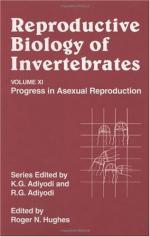|
This section contains 523 words (approx. 2 pages at 300 words per page) |

|
Sexual reproduction involves the production of new cells by the fusion of sex cells (sperm and ova) to produce a genetically different cell. Asexual reproduction, on the other hand, is the production of new cells by simple division of the parent cell into two daughter cells (called binary fission). Since there is no fusion of two different cells, the daughter cells produced by asexual reproduction are genetically identical to the parent cell. The adaptive advantage of asexual reproduction is that organisms can reproduce rapidly, and so colonize favorable environments rapidly.
Duplication of organisms, whether sexually or asexually, involves the partitioning of the genetic material (chromosomes) in the cell nucleus. During asexual reproduction, the chromosomes divide by mitosis, which results in the exact duplication of the genetic material into the nuclei of the two daughter cells. Sexual reproduction involves the fusion of two gamete cells (the sperm...
|
This section contains 523 words (approx. 2 pages at 300 words per page) |

|


